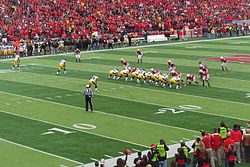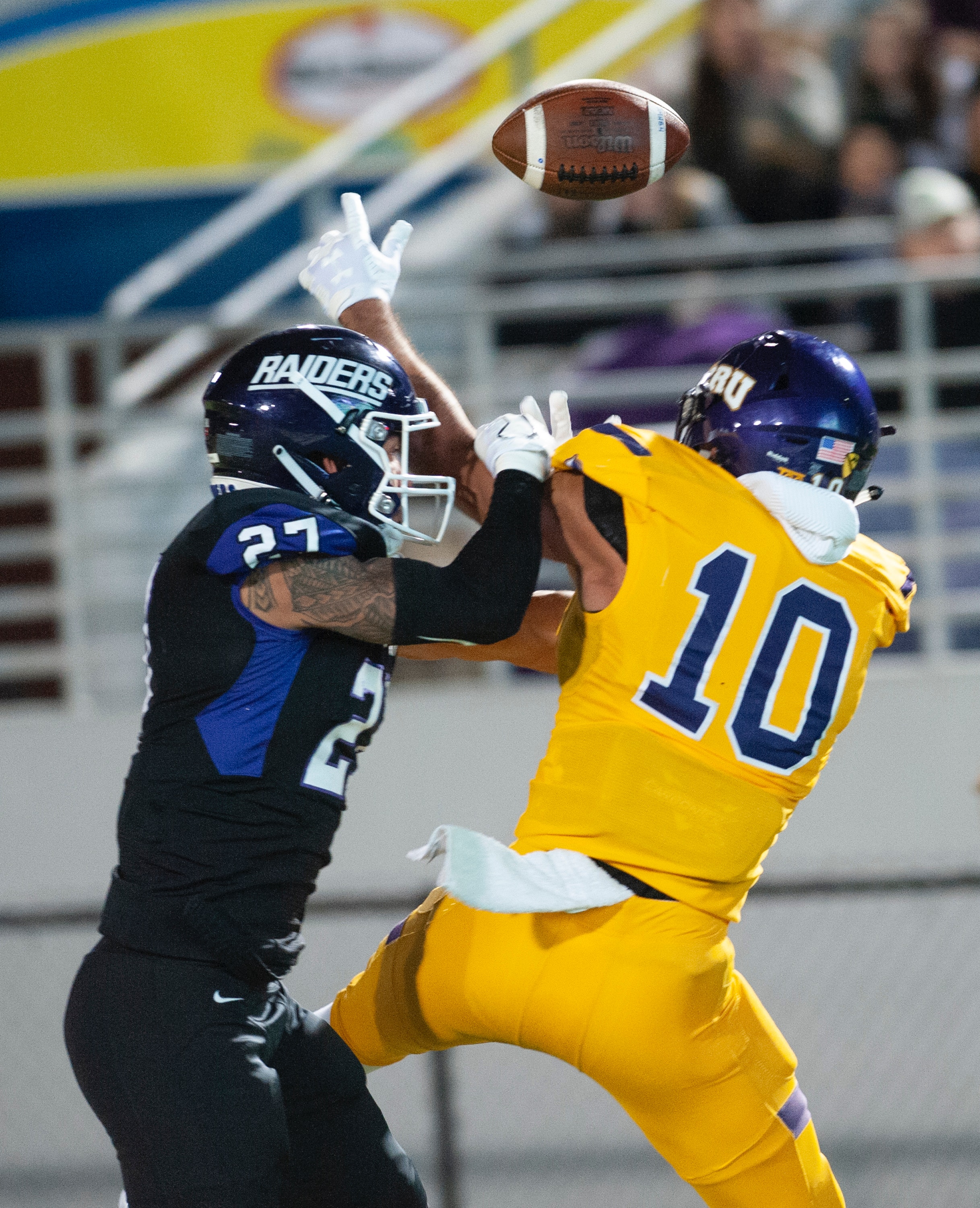General Fouls
General football fouls, as I see it, are those that do not pose harm to the other player. These are some of the most common fouls we see in college football.
If there are live-ball fouls by both teams, the fouls offset each other and the down is repeated.
Offensive Holding: 10 yards : The players facing each other over the line of scrimmage are trying to move each other out of the way to let a runner through the line (offense) or get to the runner or quarterback (defense).
They can only grab each other on the front of the chest between and below the shoulder pads. If they reach out to grab the arms, jersey, waist or any other body part it constitutes holding.
 Is this holding? Depends on who is on offense and who is on defense...
Is this holding? Depends on who is on offense and who is on defense...Defensive Holding: 10 or 15 yards: “ Defensive players may not use their hands or arms to tackle, hold, or otherwise illegally obstruct an opponent other than a runner” (NCAA.org Rule Book).
Delay of Game: 5 yards: From the end of a play, barring a timeout, the offense has either 25 or 40 seconds (depending on the referee) to start the next play. Not starting the next play before the clock hits “0” delays play, therefore a delay of game foul is called.
Ineligible Receiver Downfield: 5 yards The offensive linemen (jersey numbers 50-79) cannot go more than three yards beyond the neutral zone until a passer has thrown the ball.
Illegal Block in the Back: 10 yards: When the force of the initial contact is from behind and above the waist. With a few exceptions, a block in the back is illegal unless it is against a ball carrier
Intentional Grounding: 10 yards and loss of down: When the quarterback is about to be sacked and throws the ball into an area where there is no chance a teammate can catch it, intentional grounding is called.
Note: If the quarterback throws the ball from his own end zone and there is not an eligible receiver near enough to catch the ball, a Safety (2 points) is awarded to the defense.
Too many players on the field: 5 yards: There can only be 11 players on the field for each team. If one team has more than 11 it gives them an obvious unfair advantage. This usually occurs during times of substitution by one or both teams.
Encroachment: 5 yards: When an offensive player is lined up in the neutral zone before the ball is snapped.
Offsides: 5 yards: When a defensive player is in or beyond the neutral zone before the ball is snapped OR One or more players on the kicking team is not behind their restraining line when the ball is kicked.
False Start: 5 yards: An offensive player in set position makes a sudden movement towards the line of scrimmage or a movement like he would if the ball had already been snapped.
Neutral Zone Infraction: 5 yards: When a defensive player goes off sides and causes an offensive player to false start
NOTE: Off sides and false start are often used interchangeably but are, in fact, two different fouls.
 Players are set for the play to begin
Players are set for the play to beginKick goes out of bounds before reaching end zone: 5 yards: if the ball goes out of bounds before reaching the end zone, the ball is placed at the point where it went out of bounds and then a 5 yard penalty against the kicking team is marked off.
Taking more than 2 steps on a fair catch: 5 yards: When a player calls for and makes a fair catch, he cannot take more than 2 steps and cannot start running with the ball.
Illegal formation: 5 yards: When an illegal formation foul is called, there is something wrong with how the players are lined up before the snap.
There could be too many or too few players on the line of scrimmage, too many players in the backfield with the quarterback, or other variations from normal.
Offensive Pass Interference: 15 yards from previous spot and automatic first down: It is the responsibility of the offensive player running down the field to catch a pass to avoid the defender. If the offensive player pushes or shoves the defender out of the way or grabs the defender by the arm or jersey, it will usually be called as offensive pass interference.
 Pass interference
Pass interferenceDefensive Pass Interference: See
Note: When there is
contact beyond the neutral zone by a defensive player who is obviously trying
to keep an eligible receiver from catching the ball, and could prevent the
opportunity for the receiver to make a catchable pass.
Both players have equal rights to the ball… the defender needs to look back for the ball to prevent being called for interference. The defender cannot tackle or grasp / grab the receiver.
Note: Penalty for defensive pass interference:
If the foul occurs less than 15 yards from the line of scrimmage , the ball is placed at the spot of the foul and automatic first down is awarded.
If the foul occurs more than 15 yards from the line of scrimmage , 15 yard penalty from previous spot and automatic first down ..
Contact by a defender with an eligible receiver involving a personal foul that interferes with the reception of a catchable pass can be called either pass interference or a personal foul with the 15-yard penalty enforced from the previous spot.
Tackling or running into a receiver when a forward pass is obviously over - or underthrown is illegal but is not pass interference. It does carry a 15 yard penalty from the previous spot and an automatic first down.